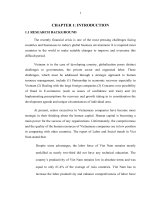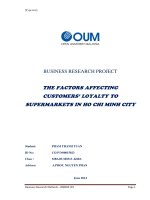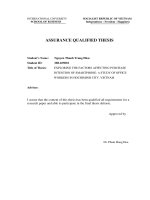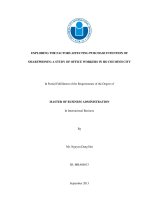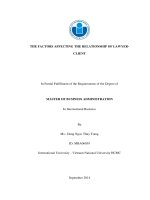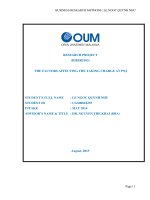The factors affecting job satisfaction at dat phu sa company
Bạn đang xem bản rút gọn của tài liệu. Xem và tải ngay bản đầy đủ của tài liệu tại đây (1.46 MB, 55 trang )
ADVISOR’S ASSESSMENT
------------------------------------------------------------------------------------------------------------------------------------------------------------------------------------------------------------------------------------------------------------------------------------------------------------------------------------------------------------------------------------------------------------------------------------------------------------------------------------------------------------------------------------------------------------------------------------------------------------------------------------------------------------------------------------------------------------------------------------------------------------------------------------------------------------------------------------------------------------------------------------------------------------------------------------------------------------------------------------------------------------------------------------------------------------------------------------------------------------------------------------------------------------------------------------------------------------------------------------------------------------------------------------------------------------------------------------------------------------------------------------------------------------------------------------------------------------------------------------------------------------------------------------------------------------------------------------------------------------------------------------------------------------------------------------------------------------------------------------------------------------------------------------------------------------------------------------------------------------------------------------------------------------------------------------------------------------------------------------------------------------------------------------------------------------------------------------------------------------------------------------------------------------------------------------------------------------------------------------------------------------------------------------------------------------------------------------------------------------------------------------------------------------------------------------------------------------------------------------------------------------------------------------------------------------------------------------------------------------------------------------------------------------------------------------------------------------------------------------------------------------------------------------------------------------------------------------------------------------------------------------------------------------------------------------------------------------------------------------------------------------------------------------------------------------------------------------------------------------------------Advisor’s signature
NGUYEN THE KHAI
1
ACKNOWLEDGEMENT
This study would not have been possible without the support and
encouragement received from so many people.
Firstly, I would like to thank to Dr. Khai Nguyen helped me complete this
thesis.
I also would like to thank to lecturers who taught me and thank all of my
friends in class who helped me during the process of learning, training and research.
Despite attempted to implement the project that’s the most complete,
beginning I do scientific research, access to reality as well as restrictions on the
knowledge and experience so i did not avoid a some shortcomings. I look forward to
feedback from lecturers and friends to get a more complete this thesis.
Finally, I would like to thank all.
2
Contents
ADVISOR’S ASSESSMENT .......................................................................................................... 1
ACKNOWLEDGEMENT ............................................................................................................... 2
LIST OF FIGURES ......................................................................................................................... 5
LIST OF TABLES ........................................................................................................................... 6
ABBREVIATIONS .......................................................................................................................... 7
ABSTRACT ...................................................................................................................................... 8
CHAPTER I: INTRODUCTION ................................................................................................... 9
1.1 Introduction about Dat Phu Sa Real Estate Company ....................................................... 9
1.1.1 General information........................................................................................................ 9
1.1.2. The goals ....................................................................................................................... 10
1.1.3. Development Principles ............................................................................................... 10
1.1.4. The mission ................................................................................................................... 10
1.1.5. Core values.................................................................................................................... 11
1.2. Research Introduction ........................................................................................................ 11
1.2.1 Problem statement ........................................................................................................ 11
1.2.2 Research engine ............................................................................................................. 12
1.2.3 Purpose of the study ...................................................................................................... 12
1.2.4 The scope of the research ............................................................................................. 13
1.2.5 Research questions ........................................................................................................ 13
CHAPTER II. LITERATURE REVIEW .................................................................................... 14
2.1 Job Satisfation ...................................................................................................................... 14
2.1.1 Theory of employee satisfaction. .................................................................................. 14
2.1.2 The studies related to employee satisfaction ............................................................... 16
2.2 Person environment fit ........................................................................................................ 17
2.3 Procedural fairness, employee voice, justification ............................................................ 19
2.4 Job role discretion ................................................................................................................ 20
2.5 Job control, cognitive demand, production responsibility ............................................... 21
CHAPTER III: RESEARCH MODEL AND HYPOTHESES .................................................. 22
3.1 Research Model .................................................................................................................... 22
3.1.1 Dependent variables ...................................................................................................... 22
3.1.2 Independent variables ................................................................................................... 22
3.1.3 Constructs ...................................................................................................................... 22
3
3.4 Research participants .......................................................................................................... 28
3.5 Procedure for Data Collection and Analyze ...................................................................... 28
CHAPTER IV: ANALYSIS AND RESULTS ............................................................................. 31
4.1 Demographic Characteristics of the respondents ............................................................. 31
4.2 Reliability Analysis .............................................................................................................. 33
4.3 Descriptive Analysis ............................................................................................................. 33
4.4 Correlation of all variables statistics .................................................................................. 34
4.5 Hypotheses Testing .............................................................................................................. 35
CHAPTER 5: CONCLUSION ...................................................................................................... 38
5.1 Summary and Discussion .................................................................................................... 38
5.2 Limitations and Further Research Recommendation ...................................................... 39
REFERENCES ............................................................................................................................... 40
APPENDIX 1 .................................................................................................................................. 43
APPENDIX 2 .................................................................................................................................. 49
4
LIST OF FIGURES
Figure 1: Proposed Research Model of Job Satisfaction in Dat Phu Sa company ……………… 18
Figure 2: A summary of demographic characteristics of the respondents ………………………. 29
5
LIST OF TABLES
Table 1 The Iinternal consistency of Cronbach’s Alpha …………………………………………... 27
Table 2 Summary of Cronbach’s Alpha of the variables …………………………………………. .31
Table 3 Descriptive Statistics …………………………………………………………………….... 31
Table 4 Summary of Correlations of all variables ………………………………………………… 32
Table 5 Model Summary of all hypotheses ……………………………………………………….. 33
Table 6 Coefficients of all hypotheses ……………………………………………………………. .34
Table 7 Hypothesis Statistic ………………………………………………………………………..35
6
ABBREVIATIONS
SPSS
Statistical Packages for the Social Science
JS
Job Satisfaction
PEF
Person Environment Fit
PEJ
Procedural Fairness, Employee Voice, Justification
JRD
Job Role Discretion
JCP
Job Control, Cognitive Demand, Production Responsibility
7
ABSTRACT
For a long time, the human factor is considered the most valuable human
resources of an enterprise, it is not only the elements that make up a competitive
advantage, but also as a vital factor for the success or failure of the enterprise.
Therefore, a study was undertaken to measure Job Satisfaction in Dat Phu Sa Real
Sstate company.
This research aimed to identify the factors that impact the satisfaction among
staff working at Dat Phu Sa Real Estate company. The research results indicated four
groups of factors (variables) which had affected on these staff’s satisfaction namely:
Satisfaction with Person Environment Fit; Procedural Fairness, Employee Voice,
Justification; Job Role Discretion; Job Control, Cognitive Demand, Production
Responsibility
Data analysis revealed that there are four factors that have the positive
relationship with Job Satisfation. Beside, relevant recommendations for improving
the employee satisfaction are proposed.
8
CHAPTER I: INTRODUCTION
1.1 Introduction about Dat Phu Sa Real Estate Company
1.1.1 General information
Name: Dat Phu Sa Trading Service Real Estate Company
The abbreviated name: Dat Phu Sa Real Estate Co..LTD
Headquarter: 36 Vu Tong Phan, An Phu ward, District 2, Ho Chi Minh city.
Dat Phu Sa Real Estate company was founded on 09/01/2010, is the
unit that operates in the field of business, consulting, management and
marketing of real estate. In 2015 marked the 5-year, that was sustainable
development of Dat Phu Sa. Every year, we have proven our success is based
on understanding the real needs of customers, the professional staff is trained
coupled with significant investment in IT systems IT service business
activities in real estate. With the continuous efforts, brand Dat Phu Sa has
become the symbol of the pioneers in the field of brokerage and marketing
organization, distribution, management and real estate valuation.
At Dat Phu Sa, we always consider the customer satisfaction is a
measure for the success of the business, so, nearly 100 staff who are trained
in the customer care skills through teaching with the guidance of domestic
9
and foreign experts. Employees join regularly the test in order to improve
professional skills.
Our company is proud to be the unit leading to providing real estate
services in the city. Our company has a team of consultants qualified real
estate professional, experienced and always get credit is important.
Customers come to us, will be very pleased with the professional work style,
effective, conscientious and very responsible of Dat Phu Sa.
We understand that customer satisfaction is the most important factor
to bring success to us.
1.1.2. The goals
Becoming a trading company specializing in distribution, marketing
agency leading real estate Vietnam and the region.
1.1.3. Development Principles
- Rapid increase in service quality for customers
- Rapidly increasing competitive advantage in the market
- Training and development of human resources inservice
Ascending scale to create solutions sales to investors
1.1.4. The mission
1.1.4.1. For the market
Provide products and services with the best quality, innovative ensure
maximum customer demand
1.1.4.2. Employees
- Develop a working environment technology - professional - dynamic
- creative
- Always relay awaken the potential energy of the staff to help
employees develop the ability, dared to live and work with the highest
intensity
10
- Create opportunities for employees to challenge the leadership,
equitable development for all employees
1.1.4.3. Society
Benefits of business will be parallel benefit society, positive contributions to
the community, demonstrating the spirit of national citizens and all mankind.
1.1.5. Core values
- Technology, speed, efficiency and customer benefits
- Investment focus
- Respecting the differences
- Understand the power serves as capable
- Valuing loyalty, collective solidarity, humane community
- Discipline organizations and legal compliance
- Develop a corporate culture based on the aspirations of the collective spirit
1.2. Research Introduction
1.2.1 Problem statement
Human are one of the social entities, influenced by many different operations.
In today's modern society pressures from work, life, etc. is increasing, so the
researchers found a solution to increase the satisfaction of people towards work, life
is necessary.
The study of the behavior, the satisfaction of human needs has been done long
ago with the famous research of Maslow, Herzberg, etc are widely applied in many
fields.
Real estate field in Vietnam is expanding due to demand, investment, building
bigger and bigger, the real estate industry is heating up in recent years in the market,
Ho Chi Minh city with many great-buildings, luxury apartments, luxury villas built
and legal policies to allow the foreigners to have to purchases and sell real estate had
attracted large external investors and should have had more real estate companies
sprang up and the increasingly fierce competition requires companies to enhance their
competitiveness. One way to compete is to attract more skilled and experienced staff
to work for the company.
Dat Phu Sa is still a small real estate company, the competitiveness of the
brand, market reputation, etc are still limited, so it has many difficulties in competing
11
for the big players like Novaland, Hung Thinh, Viet do, etc. But one of the advantages
that can be created is the working ability and experience of Dat Phu Sa’s employees.
Especially in large projects like Vinhome, Gateway, Mastery, ect.
By the way to make a strong teams with high quality employees, it can help
companies save a lot of costs (recruitment, training for new comers, etc), reduce
issues from the new staff, make a great working environment with high trust and
solidarity among all members in company. These things have the effect of making
business operations more efficient, customer confidence in the product and service
businesses more. Thus creating the competitive advantage in the market. And to
achieve these job satisfaction among the employees is a prerequisite for business,
particularly in terms of companies are many policies to attract highly qualified
workers into the single her current position.
1.2.2 Research engine
Why study "employee satisfaction for the work assigned": Labour productivity
is always a problem of all companies, the labor productivity of the worker highly
decides competitive companies. Labour productivity depends on employee’s
satisfaction, if employees are sanctified, it can make their productivity over 7 times
as usual. Currently, labor efficiency, labor productivity in company are not high,
salary of employees just 150$/month and employees must share 50% their money
from real estate sale commission, it is difficult to keep the good employees and attrack
the new comers. Now, Yes many employees resign more and more, one of the causes
were identified as the employees are unsatisfied with to their assigned jobs.
Therefore, the study of employee satisfaction is necessary, to help the company come
up with solutions to retain employees, increase employee productivity for workers
Why do I choose Dat Phu Sa: As a student of MBA programs of OUM and
Sales Manager of the company. I noticed that meets the needs of employees is a
realistic request require research for solutions to improve the satisfaction of demand
and increasing business efficiency productivity.
On the other hand, at the recent, no surveys, studies on the problem "employee
satisfaction" at the company Dat Phu Sa. So this research is to study the initial
discovery to assess the true state employees assess how they work, what things affect
their satisfaction on the job.
1.2.3 Purpose of the study
Formalized theoretical, practical basis for employee satisfaction.
12
Identification of factors and building scale quantifies the constituent elements
of employee satisfaction and building models of employee satisfaction at Dat Phu Sa
company.
Research, analyze, and evaluate the impact of these factors to the satisfaction
of the staff at Dat Phu Sa company.
Propose some solutions involve raising to raise employee satisfaction at Dat
Phu Sa company is based on research results.
1.2.4 The scope of the research
This research was conducted on 88 employees of Dat Phu Sa. It was conducted
on both employees and managers in different departments include Sales & Marketing,
Business Development, Finance and accounting, and Human Resource.
A series of formed questionnaire was distributed to each employee with clear
instructions and guidelines for fulfillment
1.2.5 Research questions
This study will focus on examining the factors influencing the hearts of staff
poorly in the company. Therefore, the following questions will be addressed within
the study:
- How much is the impact of Person Environment Fit affects employee
satisfaction like?
- Does Procedural Fairness, Employee Voice, Justification take any
affect on Job Satisfaction.
- What is the impact of Job Role Discretion on Job Satisfaction.
- How do Job Control, Cognitive Demand, Production Responsibility
take influence on Job Satisfaction.
13
CHAPTER II. LITERATURE REVIEW
2.1 Job Satisfation
The concept of job satisfaction has many different definitions from various
researchers. In this study will introduce some common concepts and introduces the
concept of job satisfaction for this study.
According to Spector (1997) job satisfaction is job one feel like work and other
aspects of their work looks like. Since it is the general assessment, so it is an
attitudinal variables.
According Kreitner and Kinicki (2007), job satisfaction levels mainly reflect
a personal favorite of his work. That is the sentiment or the feelings of the employee
for his work.
According Vroom (1964) job satisfaction is a state that employees have a clear
orientation toward efficient job in the organization.
According Hoppock (1935) suggested that satisfaction with work is general
satisfaction on the psychological, physiological and environmental factors cause a
person to really feel good about their job.
Schemerhon (1993, cited by Luddy, 2005) defines job satisfaction as the
emotional reactions and feelings towards different aspects of the work of employees.
The author emphasizes the causes of job satisfaction include job placement,
supervised by superiors, relationships with colleagues, job content, the treatment, and
the rewards include advance , physical conditions of the workplace, as well as
organizational structure.
So there are many different definitions of job satisfaction, but we can draw is
that a person is considered to have job satisfaction, he or she will feel comfortable,
pleasant to with his work.
2.1.1 Theory of employee satisfaction.
Satisfaction is the feeling of the employees feel comfortable, pleasant to work
on many sides: feelings, thoughts and actions.
Notes hierarchical needs of Abraham Maslow (1943): according to Abraham
Maslow theory of human needs are classified into five groups. The first group is the
need for "physiological" and next is the demand for "safe", "society", "respect" and
"self-improvement".
14
Theory of David Mc. Clelland (tutorial Robbins, 2002) that humans have three
demands of cobalt are: demand achievements, needs alliances and power demand.
Inside:
- The need for achievement: people with high achievement needs are
always pursuing the quyetcong the tothon. They want to overcome the difficulties
and obstacles. They want to feel that the success or failure of them as a result of the
actions of this ho. This means that they like the job have challengs. Those with high
achievement needs to be motivated to work better. General characteristics of those
with high achievement needs:
+ The desire to perform personal responsibility.
+ The trend set high goals for themselves.
+ Strong demand for specific responses, immediately.
+ Fast, early mastery of their work
- Demand league: just as the social needs of A. Maslow, it is accepted
love, friends, etc. Workers have strong needs will work fine job creating friendly and
social relations
- Demand for power: the need to control and influence other people and
their work environment. The researchers pointed out that people have strong power
demand and demand achievements tend to become managers. Some people even
argue that successful executives who demand maximum power, followed by
achievement needs and eventual need for coalition.
Theory of Herzberg two factors: factors relating to satisfaction, also known as
the encouraging factors and other factors and factors related to dissatisfaction also
called the maintenance factor.
Stacey's justice theory. John Adams: employees in organizations always want
to be treated fairly. They tend to compare contributions, his dedication to the reward
and the reward they receive (known as private equity). Moreover, they also compare
contributions, dedication, incentive and reward yourself with others (called social
justice).
Vroom's expectations theory: the psychologist Victor H. Vroom (1964)
suggests that people will be motivated to perform the work to achieve the goals if
they believe in the value of that goal and they can see that the work they do will help
them achieve their goals. Vroom's theory asserts that motivates people to work will
be determined by the value they placed on the outcome of their attempt, which was
multiplied by the belief that they have. In other words, Vroom pointed out that
15
motivation is a product of the expected value that people place on the target and the
opportunities that they see will accomplish these objectives. Vroom's theory may be
stated as follows: Motivation = rate x amorous hope
When a man indifferent to achieving the goal, the level regarded as zero fad;
and the fad will be negative when people objected to reach that goal. The outcome of
both cases are not motivated. Similarly, a person may not have any motivation to
achieve goals if hope is zero or negative.
2.1.2 The studies related to employee satisfaction
Job Description Index (JDI) of Smith, Kendall and Hulin (1969): scale job
description Index (JDI) by Smith et al (1969) established, JDI is appreciated in the
field of research research and practice. The study used 5 components satisfying aspect
of Smith's work with the following contents:
- The nature of the match: It is understood that a job would bring
satisfaction to workers generally work efficiency and create good if it meets the
following characteristics: Using different skills, personnel understand the process of
performing the work and the work has a certain importance for productive activities
for business enterprises, etc. Also suitable job with a certain capacity of workers.
- Training opportunities and promotions: Training is the process of
learning the skills needed to serve a specific job. Progression is the move to the higher
position in the system of labor work. In this topic in training and advancement are
grouped together in the same factor is a cause-effect because usually detected. The
purpose of staff training in addition to raising their level of advancement was the
purpose of the system, we have an intimate relationship with each other.
- Income: Income is working laborers revenues earned from his job at
the company. In this study, income is understood as labor income which is obtained
from the work they are doing in the company excluding the revenues outside job at
the company. Factor income is an important factor affecting the satisfaction of
employees towards work, employees have a comparison of income levels with the
other units, the income is distributed equitably among members.
- Leadership: Leadership is understood as the direct supervisor of the
employee. Leaders bring satisfaction to employees through communication with each
other, attention, attention to the employees of his subordinates, to protect employees
when necessary, express the capacity of leaders and experts subject to subordinates.
Besides the satisfaction of the employee's leadership also through fair treatment,
sincere recognition of employee contributions.
16
- Colleague: Colleagues are understood as those who work at the same
location together, with contents similar work on a chain or operations related to each
other within the organization. Content In this study be interpreted as colleagues who
work directly with the unit, the company had regular relations with each other on a
job, interested exchanged about work. Most of the time the workers come into
contact; so the relationship between colleagues together also affect general
satisfaction at work. The main factors of satisfaction are the trusted colleagues,
dedication to work and help each other in work, friendliness, etc
Model job characteristics (Job Diagnostic Survey - JDS) Richard Hackman
and Greg Oldham's (1975): based on the idea of V.Vroom, Hackman and Oldham
recommended that the satisfaction of the employees involved in the spent three
mentality at work were: a core element of their work; psychological state standards;
Results of individual and work.
Models of Associate Professor Ph.D. Tran Kim Dung AJDI (2005): Associate
Professor Ph.D Tran Kim Dung has done studies measure job satisfaction levels in
terms of Vietnam using job descriptions index ( JDI) by Smith and colleagues.
However, in addition to five factors proposed in JDI, the author has added two
additional factor is the company welfare and working conditions to suit the specific
situation of Vietnam.
The relationship between satisfaction with the personal element is made of
individual elements of workers in research models to demonstrate the personal factors
that affect job satisfaction levels of people labor or not, and the differences in personal
characteristics will lead to differences in the level of job satisfaction of employees
like.
2.2 Person environment fit
This measure was developed by Caplan, Cobb, French, Van Harrison, and
Pinneau (1980). It asks employees to provide responses to parallel sets of items
covering four job dimensions. One set of items described the employee perceptions
of what is offered by the work environment. The other set of responses described
what the employee prefers. The four job dimensions are job complexity (six item
pairs), roleambiguity (four item pairs), responsibility for persons (four item pairs),
and quantitative workload (seven item pairs). The items are averaged for each job
dimension to obtain a score for the environment (E) and a score for the person (P).
17
Person-environment fit can then be calculated by various methods, such as the
absolute value of the difference in the E and P scores.
Edwards and Van Harrison (1993) found that lack of person-environment fit
calculated as the absolute value of the difference between P and E values for job
complexity
correlated
positively
with
job
dissatisfaction,
workload
dissatisfaction,boredom, depression, anxiety, and somatic complaints. Lack of
person-environment fit in responsibility for persons correlated positively with
workload dissatisfaction, job dissatisfaction, and boredom. Lack of fit in quantitative
workload correlated positively with workload dissatisfaction, boredom, depression,
and irritation(Edwards & Van Harrison, 1993).
Even though person–situation interactions as they relate to fit have been
discussed in the scientific literature for decades, the field has yet to reach consensus
on how to conceptualize and operationalize person–environment fit. This is due partly
to the fact that person–environment fit encompasses a number of subsets, such as
person–supervisor fit and person–job fit, which are conceptually distinct from one
another (Edwards & Shipp, 2007; Kristof, 1996). Nevertheless, it is generally
assumed that person–environment fit leads to positive outcomes, such as satisfaction,
performance, and overall well-being (Ostroff & Schulte, 2007).
The theory behind person-environment fit đã everyone has a work
environment compatible with mà chúng nhất. The idea of PE is grounded Kurt
Lewin's maxim printed B = f (P, E), or printed words, behavior is a function of person
and environment. Characteristics on the side of the equation include person Interests,
preferences, KSAs (knowledge, skills and Abilities), personality traits, values, and
goals. The Environmental Factors include such 'things as vocational sewing norms,
Demands of the job, job đặc, and organizational culture and values. The basic
rationale of the theory is simple: if you work in an environment optimally compatible,
all sorts of good things happen, như improved work attitude, performance, and less
stress.
18
2.3 Procedural fairness, employee voice, justification
This measure, developed by Daly and Geyer (1994), assesses the extent to
which employees perceive that the company has used fair procedures and
incorporated employee input when making decisions that affect employees. The
measure was developed to measure these attributes surrounding an organization's
decision to relocate an employment location. The employee voice subscale assesses
the extent to which employees were able or were invited to express their views and
concerns to decision makers prior to a final decision being made. The voice measure
also includes three items that describe the extent to which management provided
adequate justification for the decision.
Analysis of structural models showed that distributive fairness, procedural
fairness, and voice/justification were empirically distinct. Procedural fairness
correlated positively with intention to remain with the organization, distributive
fairness, and voice/justification (Daly & Geyer, 1994).
Procedural fairness is a dispute resolution concept which provides an
employee a fair process in resolving disputes. The concept requires transparency,
equal communication and fairness in allocation of resources used to resolve the
dispute. Also called procedural justice. Greenberg (1987) introduced the concept of
organizational justice with regard to how an employee judges the behaviour of the
organization and the employee's resulting attitude and behaviour.
Employee voice is the two way communication between employer and
employee. It is the process of the employer communicating to the employee as well
as receiving and listening to communication from the employee. The factsheet should
be read in conjunction with our factsheet on employee communication, which goes
into greater detail on particular techniques of communication, both downward and
two-way. The two subjects clearly have a lot in common. However the concept of
employee voice focuses more on opportunities for employees to be involved in
decisions collectively, whether through trade unions or by other means. It appeals
19
both to those seeking greater business efficiency and to those looking for employee
rights. In the last two decades, organisations have increasingly focused on initiatives
that directly involve employees, moving away from representative participation.
Employee voice has been sharply discussed since 1970 when Albert Hirschman first
coined the term in his book Exit, Voice, and Loyalty. According to Stueart and Moran
(2007), participative management focuses on increasing lower level employee
empowerment through team building and direct participative methods in order to
involve the employee with the decision making of the organization.
Theory of justification is a part of epistemology that attempts to understand
the justification of propositions and beliefs. Epistemologists are concerned with
various epistemic features of belief, which include the ideas of justification, warrant,
rationality, and probability. Of these four terms, the term that has been most widely
used and discussed by the early 21st century is "warrant". Loosely speaking,
justification is the reason that someone (properly) holds a belief.
2.4 Job role discretion
This measure, developed by Gregersen and Black (1992), assesses the extent
to which employees believe their job role gives them discretion to make choices about
how and when things are done. The greater an individual's discretion as to what
workgets done, how it gets done, and by whom, the greater the empowering sense of
responsibility the individual would feel for those decisions. Thus, regardless of the
job, role discretion is likely to increase felt responsibility. Role discretion may be
particularly relevant to internationally assigned employees who are in
autonomousroles away from a parent company's headquarters (Gregersen & Black,
1992).
Role discretion was negatively correlated with role conflict and ambiguity.
Role discretion was positively correlated with role clarity, having an organizational
sponsor, organizational commitment to both the parent company and a foreign
20
operation, and work adjustment. (Gregersen & Black, 1992; Gregersen & Stroh,
1997).
2.5 Job control, cognitive demand, production responsibility
This measure, developed by Jackson, Wall, Martin, and Davids (1993),
assesses the extent of job control, cognitive demand, and production responsibility an
employee experiences in ajob. The measure covers timing control, defined as
theextent to which ajob gives an employee the freedom to determine the scheduling
of his or her work behavior, and method control, defined as the extent to which an
employee has the freedom to choose how to carry out tasks. Cognitive demand is also
assessed on two dimensions. The first is monitoring demand, defined as the extent to
which a job requires an employee to perform passive monitoring tasks. The second is
problemsolving demand, defined as the extent to which ajob involves active,
cognitive processing to prevent or detect errors. Production responsibility is defined
as the extent to which ajob involves responsibility for avoiding lost output and
damage to expensive equipment.
This control manipulation is based on previous studies using inbox activities
to investigate the effects of control (Jimmieson and Terry 1997, 1999; Parker et al.
2009, 2013). Task instructions addressed three of the five aspects of behavioral
control identified in the work control literature, including scheduling, method, and
pacing control (Jackson et al. 1993). Beside, Being faced with responsibility requires
sustained cognitive effort. Employees need to be constantly alert and vigilant; they
need to consciously control and monitor their environment by paying careful attention
to the proper completion of their tasks (Jackson et al., 1993; Payne & Rick, 1986).
Thus, well-being outcomes and especially those related to fatigue and depletion may
be affected by outcome responsibility (Martin & Wall, 1989).
21
CHAPTER III: RESEARCH MODEL AND HYPOTHESES
3.1 Research Model
Person Environment Fit
H(+)
Procedural Fairness, Employee
Voice, Justification
H(+)
H(+)
Job Satisfaction
Job Role Discretion
H(+)
Job Control, Cognitive Demand,
Production Responsibility
Figure 3 Proposed Research Model of Job Satisfaction in Dat Phu Sa company
3.1.1 Dependent variables
- Job Satisfaction (JS)
3.1.2 Independent variables
- Person Environment Fit (PEF)
- Procedural Fairness, Employee Voice, Justification (PEJ)
- Job Role Discretion (JRD)
- Job Control, Cognitive Demand, Production Responsibility (JCP)
3.1.3 Constructs
- Keyconstruct: Job Satisfaction (JS).
- Other constructs:
+ Person Environment Fit (PEF)
22
+ Procedural Fairness, Employee Voice, Justification (PEJ)
+ Job Role Discretion (JRD)
+ Job Control, Cognitive Demand, Production Responsibility (JCP)
3.2 Research hypotheses
There are four hypotheses are stated and discussed as follows:
Hypothesis 1: Person Environment Fit is positive with Job Satisfaction
in Dat Phu Sa
In today's booming economy, workers have become more important to their
employers than their employers are to them. Learn what's really important to your
employees and keep them from getting away!
Researchers have theorized that fit between individuals and their organizations
should contribute to both individual and organizational success. For example, Olian
and Rynes (1984) discussed a framework for basing staffing decisions on the degree
of fit between individual and organizational characteristics, and in doing so
speculated that "therelative effectiveness of employees with particular attitudes,
values, or personality traits islikely to vary with differences in organizational
strategy" . The presumption was that those who fit would succeed and contribute to
the success of the organization while those "who are not well matched to
organizational conditions (e.g., people with lowtolerance for ambiguity in prospector
organizations) are less likely to be effective performers in those organizations" (Olian
& Rynes, 1984, p. 178).
The results indicate that individuals should be very concerned about the degree
to which they fit in their organization. Since fit appears to lead to higher levels of
both intrinsic and extrinsic success, the consequences of not fitting are quite severe.
The current results are consistent with prior research and may help explain some of
the behaviors that have been associated with fit and misfit. fit has been shown to relate
23
to a number of positive work-related outcomes including higher job involvement
(Blau, 1987), greater organizational commitment (Meglino et aI., 1989), lower
turnover (O'Reilly et al., 1991), and improved health and adaptation (French et al.,
1982; Moos, 1987). These outcomes are quite understandable in the context of the
current study. It makes sense that those who experience extrinsic success would be
more involved in their jobs, display greater commitment, and be less likely to leave
than those who do not. It also makes sense that higher levels of job and life
satisfaction would be associated with lower turnover and more functional adaptive
behavior. It would appear then, that individuals should consider fit-based career
management strategies. Those who find themselves in organizations where they do
not fit should seriously consider the potentially limiting effects this might have
ontheir career prospects.
When staffs feel comfortable in the work environment, they will try to do more
assignment and more effective that they do not care about the welfare that they
received. Besides, this is also an advantage for the Dat Phu Sa company because the
company may retain the good staffs to create competition in the market for the other
competitors. Also, upon receiving asignment the staffs are conscious and
responsibility in the course of work.
Hypothesis 2: Procedural Fairness, Employee Voice, Justification have
positive effect on Job Satisfaction
The effective on Procedural Fairness, Employee Voice, Justification with
staff’s satisfaction playing a mediating role. The results point to the fact that profitsharing exerts a negative influence on job satisfaction, particularly whenever the
perception of procedural and interactional fairness is absent. Job satisfaction, on the
other hand, is positively influenced by the perception of fairness.
When people believe they are treated fairly, they tend to be more satisfied with
their jobs (Alexander & Ruderman, 1987; Konovsky & Cropanzano, 1991;
Masterson, Lewis, Goldman, & Taylor, 2000), more committed to their workplace
24
(Folger & Konovsky, 1989; McFarlin & Sweeney, 1992; Sweeney & McFarlin,
1993), and feel better about themselves (Tyler & Lind, 1992). Indeed, one of the most
robust findings in Job Satisfation is perceptions of procedural fairness have a strong
and enduring impact on how people feel about and react to their jobs and
organizations (Colquitt et al., 2001).
Given the pervasive influence of procedural fairness judgments, it is both
theoretically and practically important to better understand how these judgments are
formed. To date, most research examining the antecedents of procedural fairness
perceptions has focused on how situational factors, such as the characteristics of the
procedures or the opinions of co-workers, influence perceptions of fairness. For
instance, fairness judgments tend to be enhanced when procedures are based on
accurate information, are applied consistently (Bies & Shapiro, 1988; Greenberg,
1987; Leventhal, 1980; Leventhal, Karuza, & Fry, 1980), and when employees are
allowed to participate in the decision-making process (Thibaut & Walker, 1975).
Roslyn (2008) revealed that by listening to employees and achieving buy-in
on decisions involving major change in the organization and by incorporating
employees' ideas and opinions, managers would establish a participatory process
which would lead to overall employee ownership of the issue or change taking place
Hypothesis 3: Job Role Discretion has positive effect on Job Satisfation
Job Role Discretion is very important in staff’s satisfaction. The flexibility of
the staffs will help solve the job which’s easier because they have full power to
choose how to solve the problem (Gregersen and Black 1992). Staff will not be
cramped or compelled to do every step required by managers that they proactively
sought to complete the work quickly and early to save a lot of time and cost.
In addition, employees will feel freedom and comfortable. This will make employees
satisfied with their work so the company can give them more jobs for employees and
saves a lot of costs for recruitment and training
25
